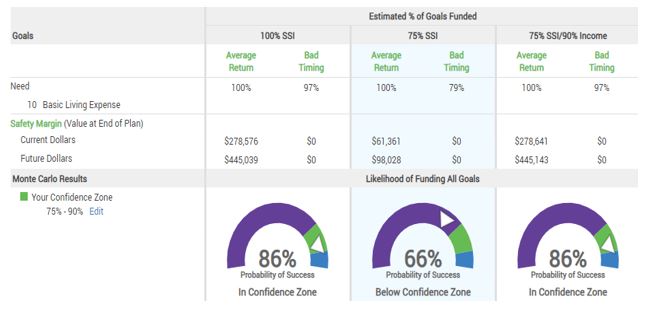Key Takeaways:
- Most retirees don’t think of Social Security as an asset and therefore exclude it from their balance sheet.
- The present value of Social Security payments over an average life expectancy can easily be several hundred thousand dollars.
- We can’t predict what will happen with Social Security down the road, so it is important that we run scenarios that include cuts in benefits, so our clients are financially prepared for the worst case.
As a child, getting to check the mailbox each day was likely an experience filled with joy. You were likely hopeful that just one piece of mail would have your name on it. Fast forward a few years, and that excitement has been replaced by reluctance. We all know what lies waiting. With the one exception coming on that glorious day, three months before your birthday each year, when your Social Security statement arrives. This statement comes yearly once you reach 60. Before that, the statement arrives once every 5 years, but you can check it anytime at ssa.gov/myaccount.
This wonderful document provides a useful projection of what you can expect to receive in benefits at various retirement ages or if you suffer a disability that prevents you from working or if you become widowed. Unfortunately, the statement provides little context around the specific benefit amounts and leaves many folks clueless on how much that monthly income figure is worth.
Given that Social Security can only be taken as a guaranteed income stream, most people don’t view their benefit as an asset. However, when we calculate the present value of these future cash flows, we see that Social Security may be the largest asset on your balance sheet. Here are a couple of examples using a single premium immediate annuity (SPIA) to replicate the lump sum amount it would take to produce a given level of income.
Let’s say you will receive $2,000/month starting at age 66 and will continue to receive this benefit for 20 years. To replicate this same income stream using an SPIA, it would cost you a one-time premium of approximately $382,000. If we bump the monthly amount from $2,000 to $3,000, the lump sum value of the benefit becomes $574,000. For married couples who both worked and earned significant wages, benefits can be worth more than a million dollars!
Whether it’s a pension or Social Security, many soon-to-be retirees underestimate what a guaranteed income stream is worth. Many also tend to overestimate how much their investments can produce and make assumptions using a higher rate of return than what is realistic. Let’s look at an example of just how important these fixed income streams can be in retirement. Our hypothetical client, Ms. Doe, is 66 years old, recently retired, needs $50,000 per year of income, and has the following investable assets: Traditional IRA – $350,000; Roth IRA – $100,000; Taxable Account – $100,000. She will receive her first Social Security check for $2,000 later this month and we will assume this will continue for the next 20 years.
When we run a Monte Carlo analysis for Ms. Doe using these figures along with a few assumptions on income needs, planning age, rate of return, and inflation, we see that she has a high probability (86%) of living out her life (in this case 20 more years) without running out of money. Now, if we assume a 25% reduction in Ms. Doe’s Social Security income from $2,000/month to $1,500/month, her likelihood of success drops from 86% all the way down to 66%. Given a 25% reduction in Ms. Doe’s Social Security benefit, she would need to cut her annual income need by 10% to get her success rate back to the original forecast of 86%.
Monte Carlo
With the numerous challenges faced by the Social Security program, estimates indicate that the funds will be able to pay full benefits for the next 20 years, but only 75-80% after that. Even though we can’t predict what will ultimately happen to these benefits, it is important to plan for these different scenarios so that our clients are financially prepared for the worst case.
Whether you’re already retired, on the fringe of retirement, or still in the middle stages of your career, it is important to understand the true value of your Social Security retirement benefits and what a vital role these benefits will likely play during your golden years. Like a pension, these fixed-income streams are often excluded not only from the traditional household balance sheet but from an overall asset allocation standpoint. The significance of Social Security income to most retirees is huge and the decisions about the timing of when to take it and how to use it can impact other assets on the balance sheet, hence the importance of understanding its place in your financial plan.


